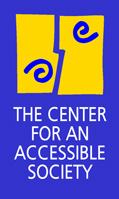
DISABILITY
ISSUES
INFORMATION
FOR JOURNALISTS
ABOUT
THE CENTER
Thu, 20 Jun 2002 -- Media Matters No. 9:
Crafting a news releaseIn Media Matters No. 8, we discussed when and why to use a news release. Today's Media Matters offers tips on preparing one.
FORMAT: Establish a standard look for your news releases and stick with it, so a reporter can easily recognize your release each time it comes. Use letterhead, with a consistent "News Release" or "Media Release" title.
CONTACT: At the start of the release, in the upper right-hand corner, list a contact person's name and phone number (and email, if available). This is headlined "For more information, contact...." If a reporter plans to do a story, she WILL try to reach these people. So choose someone comfortable talking with press and who can be reached easily -- and who will be prompt about returning reporters' calls. Provide one or two contacts -- never more than three!
HEADLINE AND KICKER: Hook reporters with your headline. Use the most intriguing aspect of the information you are focusing on. Ask yourself, "What headline would grab my attention?" You can add a "kicker" as well -- a smaller subtitle under the headline -- complementing the headline and giving more information. But don't use a kicker unless it's really necessary. Use a boldface font for the headline and kicker. The kicker is usually in a smaller font size than the headline, but both are in larger font sizes than anything else in the document.
LENGTH: Be brief. Reporters digest bits of information better than big chunks. Most reporters won't read a release of more than two pages! If you must include more detailed, technical information, make them separate attachments. Remember, key information goes at the top of the release. At the end of each page, center the word "more" so the reporter will know there's another page.
LEAD: The first paragraph is called the "lead." The lead contains the most important aspect of your story. Reporters may only read the first paragraph -- or even just the first sentence -- of your release, so your lead must make an impact. Identify your organization briefly in the first paragraph, but leave the description of your organization till the end (see below.)
BODY: The body of the news release should be concise, yet detailed enough to provide vital information related to the story. A reporter should be able to write his/her news story in its entirety using your release -- or even just a portion of the release. Organize your news release as an inverted pyramid. Place the most vital information in the first paragraph (the lede), the next most important information in the second paragraph, and so on. Background and supporting information should come later in the release. The reader should be able to eliminate paragraphs one by one, beginning at the bottom of the release, and still have enough to write a story when only the first few paragraphs remain.
QUOTES AND ANECDOTES: To give the release more credibility and realism, include quotes from key spokespersons or parties involved. Place the most important quote on the first page of the release. Reporters often ask for real-world examples to use as anecdotes, so it's good to include a real-life story to "put a face on the problem," too. Your anecdote should bolster your major points. If you're writing a release about the availability of assistive technology and you want to show the need for outreach, choose a disabled person who didn't know about an available assistive technology program whose life would be changed as a result of getting a modified computer. Always screen the person telling the story; verify their story by asking them detailed questions. Make sure the person is comfortable talking to reporters and is able to talk in detail about their situation. Be sure to get their permission to use their story.
FINISHING THE NEWS RELEASE: Include a brief description of your organization as the final paragraph of the news release. Once you have completed the release, use three number signs (###) at the bottom of the page to signify its end.
More tips on preparing a news release -- including common mistakes to avoid -- can be found at http://www.humboldt.edu/~jnhsu/publicity/newsrelease.shtml
In our next Media Matters: Sending out the news release: how to make sure it gets read.
Contact us at info@accessiblesociety.org